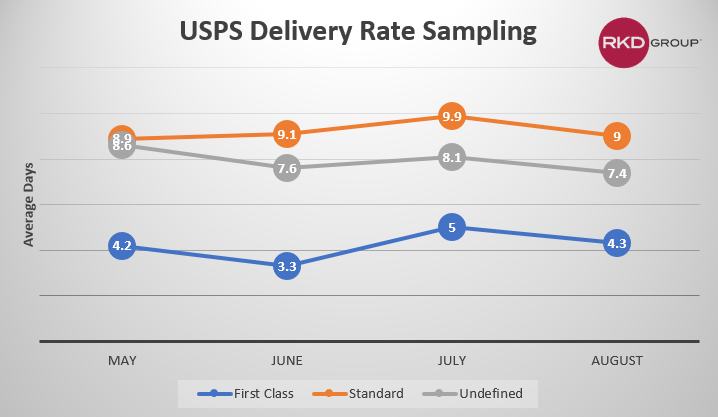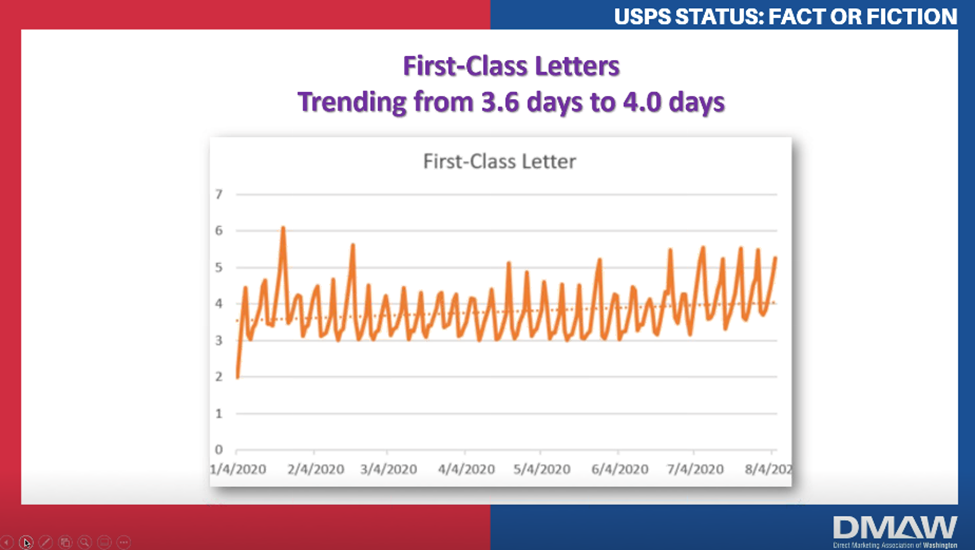Should nonprofit organizations be concerned about the U.S. Postal Service’s ability to deliver their year-end direct mail fundraising campaigns?
Purported delays this summer have sown confusion on this question, leaving some to worry not just about mail deliverability but even the survival of the postal service itself. Political partisans have latched onto the issue and attempted to stir the pot to their own advantage.
RKD Group is nonpartisan. We care about facts and data. What do they tell us about mail deliverability?
We randomly tracked aggregate delivery times of RKD client campaigns from mail production facility to residential home from May through August 2020. Our investigation found that while the average days look slightly higher in July, these numbers fall well within what we consider normal ranges.

But what are others in the industry seeing?
The Alliance for Nonprofit Mailers recently published a terrific report titled “USPS Fact vs. Politics: 15 Pieces of Information.” They noted that mail service has been performing below standards for some time, slowing down further with the start of the COVID-19 pandemic.
“The Alliance has been keeping a close eye on the delivery on nonprofit mail,” the report states. “So far, we have heard of very few unusual or new delays in mail during July and August from the nonprofit sector.”
The Direct Marketing Association of Washington just held a webinar on Aug. 26 called “USPS Status: What is Fact and What is Fiction?” In the presentation, a panel of mail experts offered their observations, and the conclusion was clear: There have been some minor delays, but there’s no need to panic.
Dave Lewis, President of SnailWorks, indicated that among the millions of pieces of mail they track every day, he’s seen a slight increase of 0.4 days in delay for first-class mail since the start of 2020. These numbers track closely with what we’re seeing.

The USPS also held their own webinar a day later for the AIM Northeast group. The postal presenters ensured viewers they are fully prepared to handle mail-in ballots, with lessons learned from a swell in mail-in voting during the 2018 midterm elections.
Regarding current capacity, the U.S. Postal Service processes 430 million pieces of mail per day. If every eligible American voted by mail in 2020, that would only account for 255 million pieces. USPS is comfortable and confident that they can handle the added volume.
Roger Craver made similar points on The Agitator, but also noted that return mail from donors could see more delays this fall.
“Because most nonprofit direct mail is pre-sorted by your mail house to match the letter carrier’s route it doesn’t have to be sorted again by the Postal Service, thus saving USPS time and labor (the reason why postal rates for pre-sorted mail are lower),” Craver noted. “This process is quite different than a personal letter or birthday card that goes through a far more complex sorting process at the Post Office.”
Between what our data shows and the data-based observations from others, it’s safe to say that the reports of widespread delays have been overstated and likely anecdotal.
This isn’t the first time that we’ve heard dramatic overtones about the impending collapse of the U.S. postal system, and it probably won’t be the last.
When it comes to confidence in the U.S. Postal service, however, we’re advising our clients to keep the faith. Mail is still being delivered at an incredibly consistent rate, and we see no reason to indicate otherwise going forward.
Also, this is no excuse to cut direct mail acquisition to save on costs. We know it’s a terrible idea for the long-term success of your fundraising.
Don’t let politics get in the way of facts as you plan your year-end fundraising this fall and winter. Direct mail still works, and it plays a crucial role in a multichannel marketing strategy.





Leave a comment: